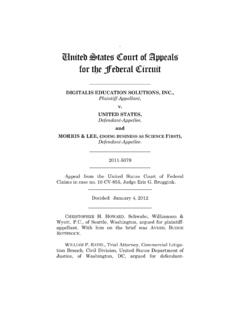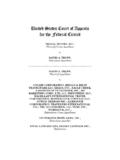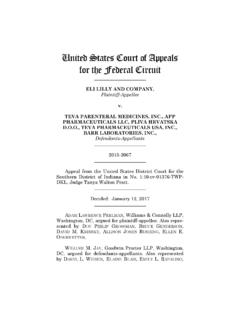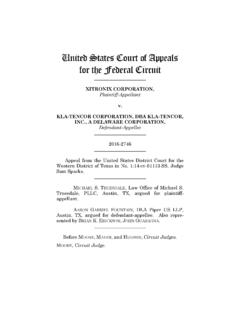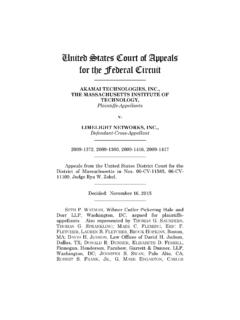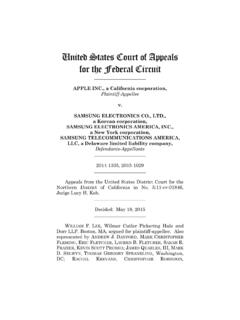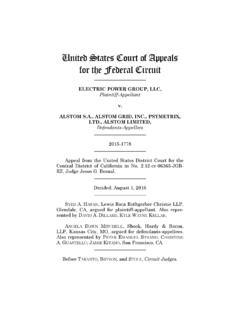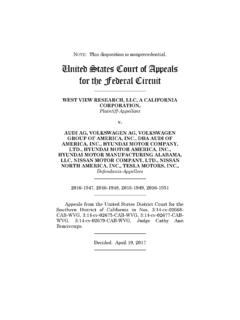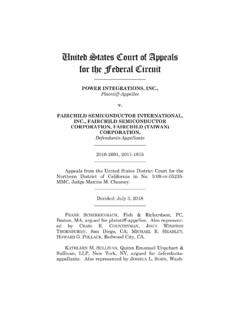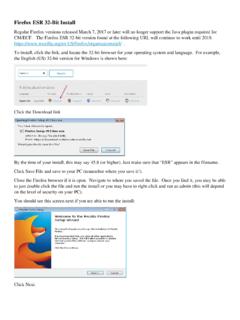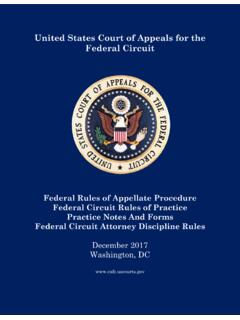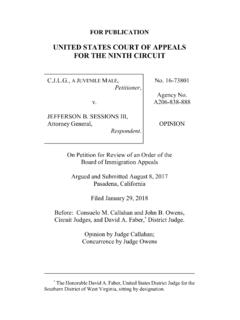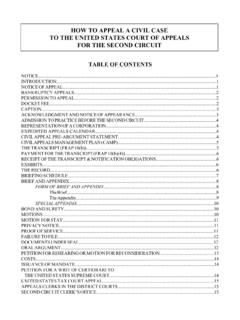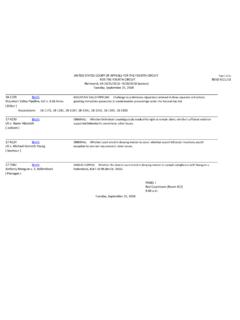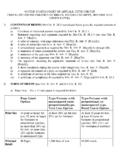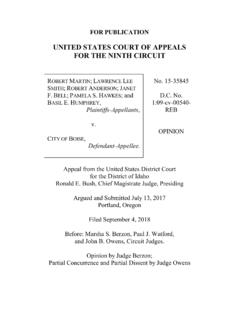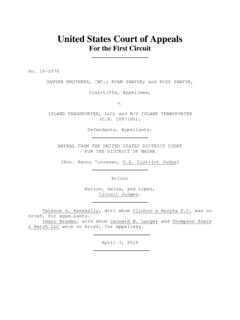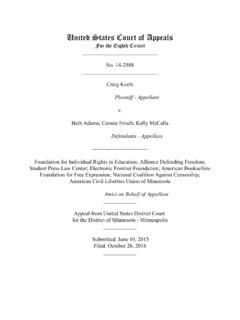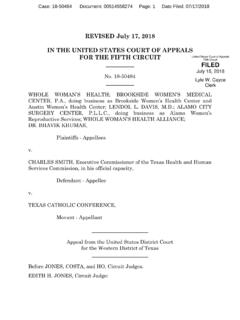Transcription of United States Court of Appeals for the Federal Circuit
1 United States Court of Appeals for the Federal Circuit _____ MELBA J. SAUNDERS, Claimant-Appellant v. ROBERT WILKIE, ACTING SECRETARY OF VETERANS AFFAIRS, Respondent-Appellee _____ 2017-1466 _____ Appeal from the United States Court of Appeals for Veterans Claims in No. 15-975, Judge Coral Wong Pi-etsch. _____ Decided: April 3, 2018 _____ MELANIE L. BOSTWICK, Orrick, Herrington & Sutcliffe, LLP, Washington, DC, argued for claimant-appellant. Also represented by ERIC SHUMSKY; PATRICK AARON BERKSHIRE, BARTON F.
2 STICHMAN, National Veterans Legal Services Program, Washington, DC. MARK E. PORADA, Commercial Litigation Branch, Civil Division, United States Department of Justice, Washing-ton, DC, argued for respondent-appellee. Also represent-ed by CHAD A. READLER, ROBERT E. KIRSCHMAN, JR., L. MISHA PREHEIM; Y. KEN LEE, JONATHAN KRISCH, Office of SAUNDERS v. WILKIE 2 General Counsel, United States Department of Veterans Affairs, Washington, DC. _____ Before NEWMAN, DYK, and O MALLEY, Circuit Judges.
3 O MALLEY, Circuit Judge. Melba Saunders Appeals from a decision of the United States Court of Appeals for Veterans Claims ( the Veter-ans Court ) denying her entitlement to disability benefits based on her reported pain from bilateral knee disorders. Saunders v. McDonald, No. 15-0975, 2016 WL 3002862 (Vet. App. May 25, 2016) (Saunders I), aff d, 2016 WL 4258493 (Vet. App. Aug. 12, 2016) (Saunders II) (affirmed by a three-judge panel). The Veterans Court erred as a matter of law in finding that Saunders s pain alone, absent a specific diagnosis or otherwise identified disease or injury, cannot constitute a disability under 38 1110 (2016).
4 We therefore reverse the Veterans Court s legal determination and remand for further proceedings. I. BACKGROUND Saunders served on active duty in the Army from No-vember 1987 until October 1994. Saunders I, 2016 WL 3002862, at *1. Saunders did not experience knee prob-lems before serving in the Army. During her service, however, Saunders sought treatment for knee pain and was diagnosed with patellofemoral pain syndrome ( PFPS ). Id. Saunders s May 1994 exit examination reflected normal lower extremities but noted Saunders s reporting of a history of swollen knee and hip joints and bone spurs on her feet.
5 In 1994, Saunders filed a claim for disability compen-sation for knee pain, hip pain, and a bilateral foot condi-tion. Id. The VA Regional Office ( RO ) denied Saunders s claim because she failed to report for a re-SAUNDERS v. WILKIE 3 quired medical examination. Saunders did not appeal that decision. In 2008, Saunders filed a new claim for a bilateral knee disability and for foot issues. The RO treated this application as a request to reopen the prior decision, granted the request, and denied both claims on the mer-its.
6 As to Saunders s knee claim, the RO noted in the rating decision that Saunders was diagnosed with PFPS while in service, but the RO had not received any current medical evidence related to Saunders s knee condition. In 2009, Saunders submitted a Notice of Disagree-ment, explaining that she had sustained injuries to [her] knees while on active duty, citing the PFPS diagnosis, and stating that she was still experiencing pain and swelling in [her] knees. 643 44. The RO denied this claim in February 2010, citing a lack of evidence of treat-ment for a knee condition.
7 Saunders appealed this deci-sion to the Board of Veterans Appeals ( the Board ). During a 2011 VA examination, the examiner noted that Saunders reported experiencing bilateral knee pain while performing various activities such as running, squatting, bending, and climbing stairs. The examiner found that Saunders had no anatomic abnormality, weakness, or reduced range of motion. The examiner also noted that Saunders had functional limitations on walk-ing, that she was unable to stand for more than a few minutes, and that sometimes she required use of a cane or brace.
8 The examiner diagnosed Saunders with subjective bi-lateral knee pain and found that this pain led to (1) increased absenteeism and (2) effects on Saunders s ability to complete daily activities. The examiner also concluded that Saunders s knee condition was at least as likely as not caused by, or a result of, Saunders s military service. The VA later explained that pain could not be provided as a diagnosis for Saunders s knee condition, and SAUNDERS v.
9 WILKIE 4 requested that the examiner provide a complete rationale for the diagnosis. In a supplemental report, the examiner stated there was no pathology to render a diagnosis on Saunders s condition, and noted that the theory of causa-tion was based on the chronology of events during Saun-ders s service. After reviewing the supplemental report, the RO once again denied Saunders s claim because, in its view, Saunders had not demonstrated a currently diag-nosed bilateral knee condition linked to military service.
10 Saunders appealed to the Board. Before the Board, Saunders argued that, because the examiner found that her knee conditions were linked to her service, and be-cause she was treated while in service and afterwards for knee pain, she had sufficiently demonstrated service connection for her condition. The Board reopened Saun-ders s knee claim, concluding the additional evidence she offered was new and material, but denied her claim on the merits. The Board acknowledged that Saunders was diagnosed while in service with PFPS and that the exam-iner found that Saunders s knee condition was likely related to her active service.
